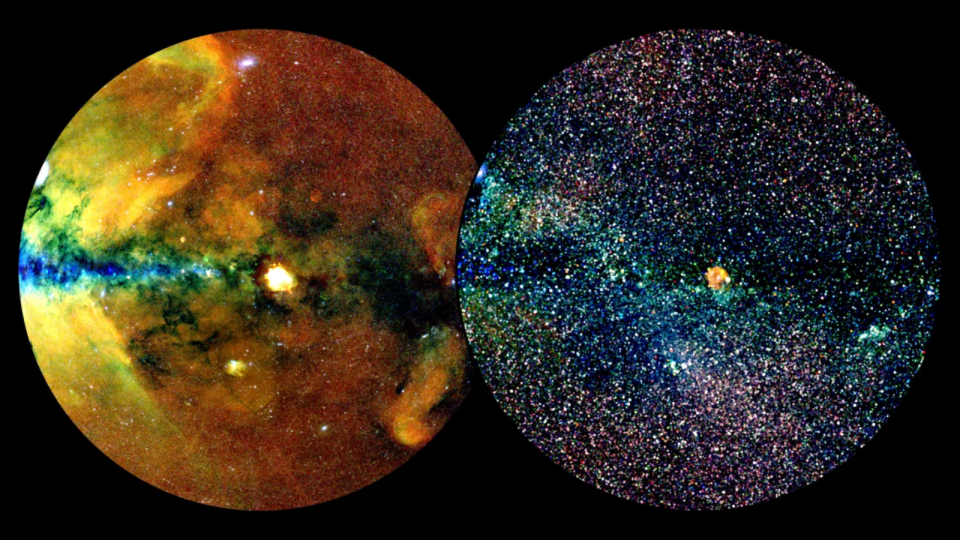The initial data from the eROSITA sky survey offers an X-ray perspective of half the sky over Earth, capturing almost a million high-energy cosmic sources, including over 700,000 supermassive black holes. This catalog, called the “eROSITA All-Sky Survey Catalogue (eRASS1)” was released on Thursday (Feb. 1). It is the most extensive catalog of the universe’s most potent sources of energy, such as exploding massive stars and black hole-powered active galactic nuclei that radiate intensely in X-rays. The release also describes the largest known structures in the universe — cosmic web filaments of hot gas that link galaxies in clusters. The results reveal that in just half a year of operations following its launch on July 13, 2019, eROSITA has found more high-energy X-ray sources than have been discovered in six decades of surveying the sky. Seen as a significant achievement in the 60 or so years of X-ray astronomy, eRASS1 could contribute to answering some of cosmology’s most significant questions: How did the universe evolve, and why is the very fabric of space expanding at an accelerating rate? Related: Mysterious dark energy is spread evenly across the cosmos
 On the left, a yellow circle with smoky patterns. On the right, a blue hued circle that’s sparkly with stars. Accompanying the eRASS1 data are almost 50 scientific papers published across a range of topics, adding to an existing 200 papers already written using data from the eROSITA telescope. The primary objective of eROSITA is to observe how dark energy accelerates the expansion of the universe using clusters of galaxies; however, these 250 or so papers demonstrate how the instrument and its data have surpassed this goal. These papers include the discovery of over 1,000 superclusters of galaxies, the revelation of two quasi-periodic erupting black holes, and the determination of the influence of stars’ X-ray radiation on water and atmosphere retention of planets orbiting them. “The scientific breadth and impact of the survey is quite overwhelming; it’s hard to express in a few words,” spokesperson for the German eROSITA consortium, Mara Salvato, said in a statement. “But the papers published by the team will speak for themselves.” eROSITA lets the numbers do the talking The eRASS1 data consists of eROSITA telescope observations conducted from Dec. 12, 2019, to June 11, 2020, across half the sky over Earth. During this period, the space telescope detected around 170 million individual particles of X-ray light or “photons.” Processing these photons revealed 900,000 X-ray sources, of which 700,000 are feeding supermassive black holes that power quasars at the hearts of active galactic nuclei, regions in the centers of galaxies so bright they can outshine the combined light of every star in those galaxies themselves. Also seen in the eRASS1 are 180,000 X-ray-emitting stars in the Milky Way, 12,000 clusters of galaxies and even exotic classes of X-ray sources like binary stars, supernova remnants, pulsars and other such objects. “These are extraordinary numbers for X-ray astronomy,” Andrea Merloni, eROSITA principal investigator and first author of the eROSITA catalog paper, said in a statement. “We’ve detected more sources in 6 months than the big flagship missions XMM-Newton and Chandra have done in nearly 25 years of operation.” RELATED STORIES:— New satellite will able to see ‘X-ray rainbow’ from huge objects in space— Hundreds of supernova remnants remain hidden in our galaxy. These astronomers want to find them— India launches X-ray satellite to study black holes and more The data release is also impressive in terms of the spread of its observations, with the sky over Earth imaged at multiple X-ray energies. In addition to this, eROSITA is incredibly precise, with its first data release also pinpointing positions in the sky from which individual photons are received, as well as these photons’ arrival times and energies.Along with the release, the eROSITA Consortium has also made available the software needed to analyze data from the X-ray telescope as well as catalogs that go beyond just X-ray data. “We’ve made a huge effort to release high-quality data and software,” eROSITA Operations team leader, Iriam Ramos-Ceja, said. “We hope this will broaden the base of scientists worldwide working with high-energy data and help push the frontiers of X-ray astronomy.”
On the left, a yellow circle with smoky patterns. On the right, a blue hued circle that’s sparkly with stars. Accompanying the eRASS1 data are almost 50 scientific papers published across a range of topics, adding to an existing 200 papers already written using data from the eROSITA telescope. The primary objective of eROSITA is to observe how dark energy accelerates the expansion of the universe using clusters of galaxies; however, these 250 or so papers demonstrate how the instrument and its data have surpassed this goal. These papers include the discovery of over 1,000 superclusters of galaxies, the revelation of two quasi-periodic erupting black holes, and the determination of the influence of stars’ X-ray radiation on water and atmosphere retention of planets orbiting them. “The scientific breadth and impact of the survey is quite overwhelming; it’s hard to express in a few words,” spokesperson for the German eROSITA consortium, Mara Salvato, said in a statement. “But the papers published by the team will speak for themselves.” eROSITA lets the numbers do the talking The eRASS1 data consists of eROSITA telescope observations conducted from Dec. 12, 2019, to June 11, 2020, across half the sky over Earth. During this period, the space telescope detected around 170 million individual particles of X-ray light or “photons.” Processing these photons revealed 900,000 X-ray sources, of which 700,000 are feeding supermassive black holes that power quasars at the hearts of active galactic nuclei, regions in the centers of galaxies so bright they can outshine the combined light of every star in those galaxies themselves. Also seen in the eRASS1 are 180,000 X-ray-emitting stars in the Milky Way, 12,000 clusters of galaxies and even exotic classes of X-ray sources like binary stars, supernova remnants, pulsars and other such objects. “These are extraordinary numbers for X-ray astronomy,” Andrea Merloni, eROSITA principal investigator and first author of the eROSITA catalog paper, said in a statement. “We’ve detected more sources in 6 months than the big flagship missions XMM-Newton and Chandra have done in nearly 25 years of operation.” RELATED STORIES:— New satellite will able to see ‘X-ray rainbow’ from huge objects in space— Hundreds of supernova remnants remain hidden in our galaxy. These astronomers want to find them— India launches X-ray satellite to study black holes and more The data release is also impressive in terms of the spread of its observations, with the sky over Earth imaged at multiple X-ray energies. In addition to this, eROSITA is incredibly precise, with its first data release also pinpointing positions in the sky from which individual photons are received, as well as these photons’ arrival times and energies.Along with the release, the eROSITA Consortium has also made available the software needed to analyze data from the X-ray telescope as well as catalogs that go beyond just X-ray data. “We’ve made a huge effort to release high-quality data and software,” eROSITA Operations team leader, Iriam Ramos-Ceja, said. “We hope this will broaden the base of scientists worldwide working with high-energy data and help push the frontiers of X-ray astronomy.”














